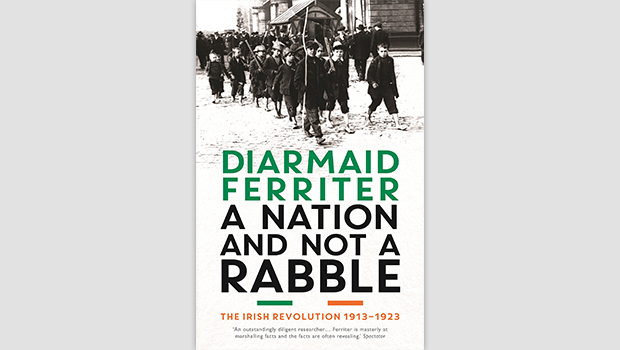Reviewed by Msgr. Francis A. Carbine
In 2016, the people of the Republic of Ireland and Irish Diaspora will observe the centenary of the Rising. This event on Easter Monday in Dublin, 1916, led to Ireland’s War of Independence [1919-1920]. An Anglo-Irish treaty was ratified in 1922. English dominance in twenty -six counties ended.
What will Irish men and women say, however, about Ireland’s Civil War [1922 – 1923]? Pro-Treaty and Anti-Treaty factions clashed. Hundreds died. The ultimate victim was the “Big Fellow,” Michael Collins, assassinated in 1922. The Civil War tore the heart out of Ireland.
Yeats’ “Meditations in the Time of Civil War” describes the “senseless tumult”: “the rage-driven, rage-tormented, and rage-hungry troop,/Trooper belaboring Trooper, biting at arm or at face…”
What will 2016 commemorate?
How are the leaders of 1916 to be perceived? Were they mystical nationalists inhabiting an “island of slumbering saints”? Were they romantics endeavoring to build an impossible future upon an imaginary past?
Were they, in words of Sean O’Casey, like James Connolly – romantics who “stared into the sky for a green dawn”?
Or were these patriots as lady Gregory remarked “a rabble with no apparent policy”? Were they discordant pragmatists, and “wild men screaming through the keyhole”? Was the Rising a “bloody conspiracy of a minority within a minority”? The author poses these questions.
Historians studying 1913 – 1923 have developed conflicting perspectives. “A Nation and Not a Rabble” by Diarmaid Ferriter [2015] makes use of major archives to impart “layered knowledge” of the context of 1916. His scholarly research is indicated by 47 pages of notes.
The book is an Encyclopedia Hibernica. Diarmaid Ferriter guides readers through the gallery of men and women who altered Irish history: James Connolly, Eamon de Valera, Patrick Pearse, Roger Casement, Delia Larkin, Constance Markievicz, Helena Molonoy, Hannah Skiffington – to hint at the multitude.
The author also identifies events without number. The Gaelic League and Gaelic Athletic Association [GAA] were founded in the 1890s. The 1913 lockout of Dublin Transport Workers contributed to formation of the Irish Citizen Army – future IRA.
The 1913 commemoration of three Manchester Martyrs [1879]; issue of Home Rule; history books emphasizing “Ireland’s glorious past”; Great War and Conscription Crisis of 1918 — all were events contributing to a surging nationalism.
Not overlooked is the role of the “Black and Tans” who arrived in Ireland in 1920. “Without proper training or assessment of suitability,” these British mercenaries sacked the town of Balbriggan, County Dublin, and set fire to areas in the City of Cork.
In their ill-matched uniforms, these para-military men were encouraged to suppress “rebellion.” They brutalized civilian populations, and acted out their “mission of destruction.”
The role of the Catholic Church in Irish republican identity was a fact. There was, however, no Catholic political position. In teaching patriotism, the Irish Christian Brothers created gunmen!
Archbishop Walsh of Dublin made politics as much his business as religion. Cardinal Logue of Armagh distrusted the Ancient Order of Hibernians. He was disappointed by the Partition but favored the Treaty.
Puzzling to the British, the clergy supported Irish Republicanism but simultaneously ministered to Irish soldiers in the British army.
The six counties that today comprise Northern Ireland enjoyed an industrial prosperity connected to England. The northern Orange Order propagandized that Rome was behind Sinn Fein.
Northern Unionists also feared double taxation: by England and Ireland! The Ulster Volunteer Force was founded in 1913. For major reasons, Orangemen were “prepared with one voice” to speak against Ireland as one country.
“A Nation and Not a Rabble” has a lofty ideal: “ensuring that young Irish citizens would have a good knowledge of what happened in 1916 and why.” Early chapters [Part I] provide an annotated bibliography of selected historic writings.
Certain chapters [Part II] are notably fast paced: v.g. “War of Independence,” “Drift to Civil War,” and ‘Civil War.”
For pathos, there is the candlelight wedding of Joseph Plunkett and Mary Gifford hours before his execution in the Stonebreakers Yard, Kilmainham Jail, Dublin, 1916.
Generating great emotional interest are Kevin Barry — “a lad of 18 summers” — executed in Mountjoy Jail, Dublin, 1920; and Terence MacSwiney, Mayor of Cork, who died on day 74 of his hunger strike in Brixton Prison, England. His death was also in 1920.
While Dublin’s Four Courts were being shelled during Ireland’s Civil War, Father Albert, a Franciscan and republican sympathizer, was present. He later wrote: “ The boys all knelt down and recited a decade of the rosary in Irish.” Such memorable moments abound.
The Hiring Fairs, part of the contemporary, social context, were held in a number of Irish towns. These Fairs were “slave markets” where often rapacious employers hired Irish children to work on harvests in Ireland, England and Scotland.
Patrick MacGill was one such boy. He was brought to the Hiring Fair in Donegal at the age of twelve, because “there’s hope beyond the mountains for a little boy of twelve.”
The “Legacy of the Revolution” [Part III] points out the complex challenges facing the New Irish State: urban slums, tuberculosis, land grants, pensions, establishment of courts, and additional issues. Many matters could not be resolved until Ireland left the British Commonwealth and became a Republic in 1949.
Diarmaid Ferriter points out that all revolutions are a “weird composite of idealism, neurosis, megalomania and criminality.”
In 2012, Martin McGuinness, Sinn Fein Deputy in Northern Ireland, shook hands with Queen Elizabeth II in Belfast. In 2014, Michael Higgins, President of Ireland paid a state visit to England.
In ”Easter 1916,” W. B. Yeats poetically noted that “A shadow of cloud on the stream/ Changes minute by minute.” In the 2016 Centenary, what, how and with whom are we to celebrate?

